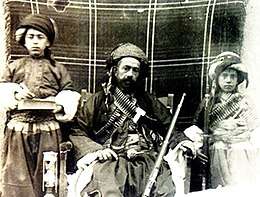Mahmud Barzanji revolts
Mahmud Barzanji revolts were a series of armed uprisings by Kurdish Sheykh Mahmud Barzanji against the Iraqi authority in newly conquered British Mesopotamia and later the British Mandate in Iraq. Following his first insurrection in May 1919, Sheykh Mahmud was imprisoned and eventually exiled to India for a one-year period. When returning, he was once again appointed a governor, but shortly revolted again declaring himself as the ruler of the Kingdom of Kurdistan. The Kingdom of Kurdistan lasted from September 1922 – July 1924.[1] With British forces greatly exceeding his in ammunition and training, the defeat finally subdued the region to central British Iraqi rule in 1924. Sheykh Mahmud retreated into mountains, and eventually reached terms with the independent Kingdom of Iraq in 1932, over his return from the underground. Sheykh Mahmud revolts are considered the first chapter of the modern Iraqi–Kurdish conflict.
Background
Shortly after the final accords of World War I, the Sheykh of the Qadiriyya order of Sufis, the most influential personality in Iraqi Kurdistan,[2] was appointed Governor of the former sanjak of Duhok.
1919 Kurdish revolt
Sheykh Mahmud led the first Kurdish revolt in British controlled Iraqi Kurdistan (Iraqi Kurdistan) in May 1919. Shortly before being appointed governor of Sulaymaniyah, he ordered the arrest of all British political and military officials in the region. After seizing control of the region, Sheikh raised a military force from his Kurdish tribal followers and proclaimed himself "Ruler of all of Kurdistan". Using his authority as a religious leader, Sheykh Mahmud called for a jihad against the British in 1919 and thus acquired the support of many Kurds indifferent to the nationalist struggle. Although the intensity of their struggle was motivated by religion, Kurdish peasantry seized the idea of "national and political liberty for all" and strove for "an improvement in their social standing".
Tribal fighters from both Iran and Iraq quickly allied themselves with Sheykh Mahmud as he became more successful in opposing British rule. According to McDowall, the Sheykh's forces "were largely Barzinja tenantry and tribesmen, the Hamavand under Karim Fattah Beg, and disaffected sections of the Jaf, Jabbari, Sheykh Bizayni and Shuan tribes".[3] The popularity and numbers of Sheykh Mahmud's troops only increased after their ambush of a British military column.
Among the supporters of Sheykh Mahmud was also the 16-year-old Mustafa Barzani, who was to become the future leader of the Kurdish nationalist cause and a commander of the Peshmerga forces. Barzani and his men, following the orders of Barzani tribal Shekyh Ahmed Barzani, crossed the Piyaw Valley to join Sheykh Mahmud Barzanji. Even though being ambushed several times, Barzani and his men reached Sheykh Mahmud's location, but arrived too late to aid in the revolt.[4] The Barzani fighters were only a part of the Sheykh's 500-person force.
As the British became aware of the sheykh's growing political and military power, they were forced to respond militarily. Two British brigades were deployed to defeat Sheykh Mahmud's fighters at Darbandi Bazyan near Sulaymaniyah in June 1919.
Sheykh Mahmud's exile
Sheykh Mahmud Barzanji was arrested and sent into exile to India in 1921.[4] Mahmud's fighters continued to oppose British rule after his arrest. Although no longer organized under one leader, this intertribal force was "actively anti-British", engaging in hit-and-run attacks, killing British military officers, and participating in another – left the Turkish ranks to join the Kurdish army.
1922 Kurdish revolt
After the Treaty of Sèvres, which settled some territories, Sulaymaniyah still remained under the direct control of the British High Commissioner. After the subsequent penetration of the Turkish "Özdemir" Detachment into the area, an attempt was made by the British to counter this by appointing Sheykh Mahmud, who was returned from his exile, as Governor once again, on 14 September 1922.[5]
The Sheykh revolted again and in November declared himself King of the Kingdom of Kurdistan. Members of his cabinet included:.[6] The army of the Kingdom of Kurdistan was called the Kurdish National Army.
Barzanji was defeated by the British in July 1924. After the British government finally defeated Sheykh Mahmud, they signed Iraq over to King Faisal I and a new Arab-led government. In January 1926, the League of Nations gave the mandate over the territory to Mandatory Iraq, with the provision for special rights for Kurds.
Aftermath
Following the defeat Sheykh Mahmud retreated into the mountains. In 1930–1931, Sheykh Mahmud Barzanji made his last unsuccessful attempt to gain power.
He later signed a peace accord with the new Iraqi government, returning from the underground to the independent Iraq in 1932.[7]
References
- Prince, James M. (January 1993). "A Kurdish State in Iraq?". Current History. 92 (570): .
- Eskander, Saad (2000). "Britain's Policy in Southern Kurdistan: The Formation and the Termination of the First Kurdish Government, 1918–1919". British Journal of Middle Eastern Studies. 27 (2): 139–163. doi:10.1080/13530190020000501.
- McDowall, David (2007) [1996]. "The Kurds, Britain and Iraq". A Modern History of the Kurds (3rd ed.). I.B. Tauris. p. 158. ISBN 978-1-85043-416-0.
- Lortz, Michael G. (2005). "Chapter 1: Introduction: The Kurdish Warrior Tradition and the Importance of the Peshmerga" (PDF). Willing to Face Death: A History of Kurdish Military Forces — the Peshmerga — from the Ottoman Empire to Present-Day Iraq (Thesis). Florida State University. p. 11. Archived from the original (PDF) on 29 October 2013.
- Khidir, Jaafar Hussein (March 2004). "The Kurdish National Movement" (PDF). Kurdistan Studies Journal (11): 14. Archived from the original (PDF) on 22 July 2004.
- Fatah, Rebwar (12 April 2006). "The Kurdish resistance to Southern Kurdistan annexing with Iraq". KurdishMedia.com. Archived from the original on 18 April 2006.
- Lortz, Michael G. (2005). "Chapter 1: Introduction: The Kurdish Warrior Tradition and the Importance of the Peshmerga" (PDF). Willing to Face Death: A History of Kurdish Military Forces — the Peshmerga — from the Ottoman Empire to Present-Day Iraq (Thesis). Florida State University. Archived from the original (PDF) on 29 October 2013.
